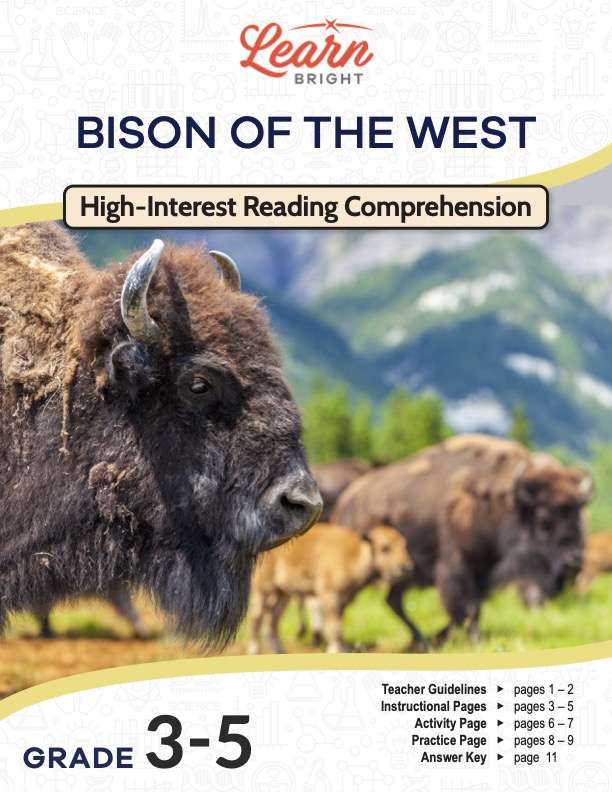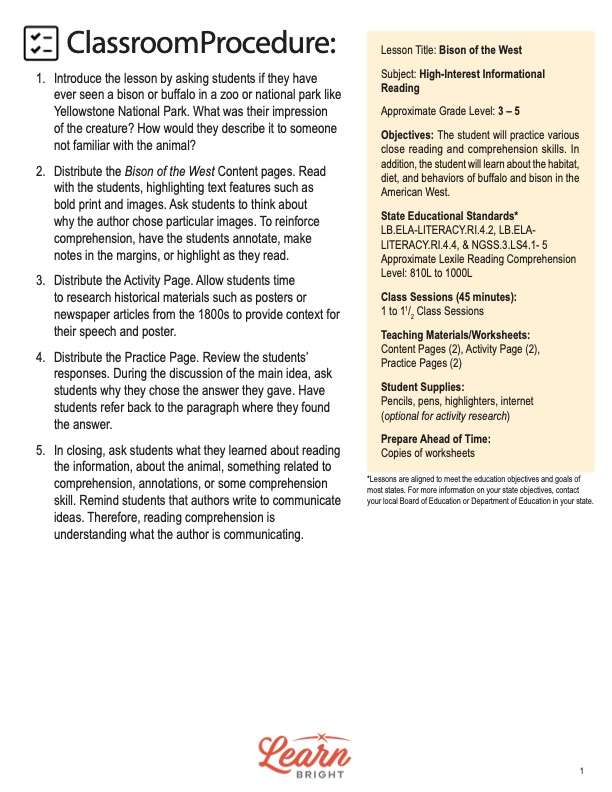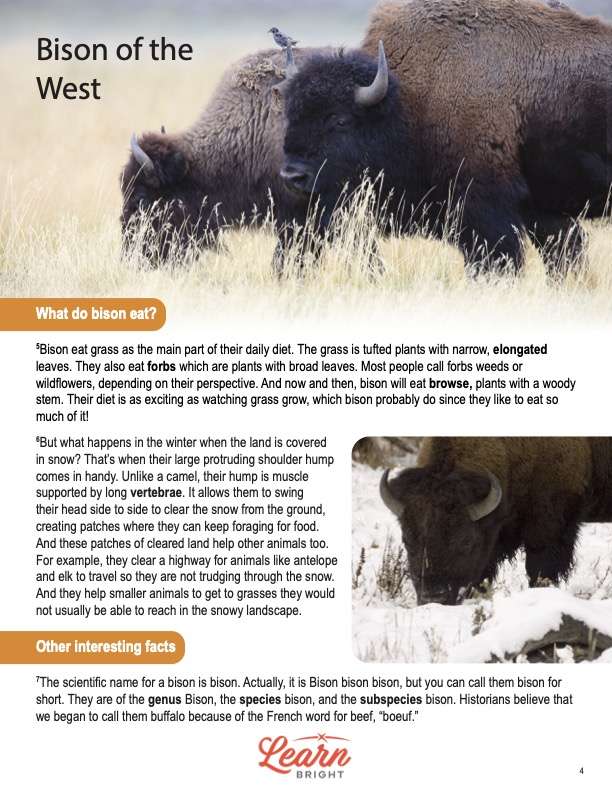Description
What our Bison of the West lesson plan includes
Lesson Objectives and Overview: Bison of the West is a high-interest reading comprehension lesson plan. As such, students will practice various close reading and comprehension skills. In addition, they will learn about the habitat, diet, and behaviors of bison. This lesson is for students in 3rd grade, 4th grade, and 5th grade.
Classroom Procedure
Every lesson plan provides you with a classroom procedure page that outlines a step-by-step guide to follow. You do not have to follow the guide exactly. The guide helps you organize the lesson and details when to hand out worksheets. It also lists information in the yellow box that you might find useful. You will find the lesson objectives, state standards, and number of class sessions the lesson should take to complete in this area. In addition, it describes the supplies you will need as well as what and how you need to prepare beforehand.
Teacher Notes
The teacher notes page provides an extra paragraph of information to help guide the lesson and remind you what to focus on. It explains that you can teach this lesson in a whole-class setting or to an independent, small group as an activity. The blank lines on this page are available for you to write out thoughts and ideas you have as you prepare the lesson.
BISON OF THE WEST LESSON PLAN CONTENT PAGES
Bison vs. Buffalo
The Bison of the West lesson plan contains four content pages. To start off, it provides a small box with basic background information about the bison. Bisons are mammals that inhabit North America and Europe. Their diets include plants and grasses, and they can live between 10 and 20 years.
Buffalos are large mammals that live in Africa and Asia. In Africa, buffalo is called the cape buffalo; in Asia, they are called water buffalo. Did you know that buffalos don’t actually live in the United States? The animal that many people call a buffalo is a different animal called a bison!
Bison are similar to buffalo, yak, and cattle. There are two species of bison in the world: the American bison and the European bison. Bison are the largest land mammals in both North America and Europe. They can weigh up to 2,000 pounds and are usually over 6 feet tall and 10 feet long. And both the males and females have horns.
Even though they are huge animals, bison are fast and agile. They can run up to 35 miles an hour, which helps them to outrun some predators. Plus, they can spin around quickly, jump high fences, and are strong swimmers. All of these attributes help bison to avoid being eaten by predators. Predators like wolves can defeat only sick bison.
What Do Bison Eat?
If you are a bison, you only eat from the salad bar! That’s because bison are herbivores, meaning they only eat plants. They primarily eat grasses, weeds, and leafy plants. Bison spend most of their day eating. As the sun rises, bison wake up in groups of three to four and head out to graze. They eat their fill and then rest. Then they go out to eat more and come back to rest. Then again, they go out to eat more and return to rest. They keep doing this for 9 to 11 hours each day. It is estimated that bison eat about 1.6% of their body mass per day of dry vegetation. That equals 24 pounds a day of grass.
Bison eat grass as the main part of their daily diet. The grass is tufted plants with narrow, elongated leaves. They also eat forbs which are plants with broad leaves. Most people call forbs weeds or wildflowers, depending on their perspective. And now and then, bison will eat browse, plants with a woody stem. Their diet is as exciting as watching grass grow, which bison probably do since they like to eat so much of it!
But what happens in the winter when the land is covered in snow? That’s when their large protruding shoulder hump comes in handy. Unlike a camel, their hump is muscle supported by long vertebrae. It allows them to swing their head side to side to clear the snow from the ground, creating patches where they can keep foraging for food. And these patches of cleared land help other animals too. For example, they clear a highway for animals like antelope and elk to travel so they are not trudging through the snow. And they help smaller animals to get to grasses they would not usually be able to reach in the snowy landscape.
Other Interesting Facts
The scientific name for a bison is bison. Actually, it is Bison bison bison, but you can call them bison for short. They are of the genus Bison, the species bison, and the subspecies bison. Historians believe that we began to call them buffalo because of the French word for beef, “boeuf.”
Today, Yellowstone National Park is the central place where American bison continuously live with protection by park authorities. The bison in this park are super special because they are descendants of the original early bison that roamed the grasslands. Plus, at @5,450 bison, it is the largest herd on public lands. The bison freely roam around the park and some parts of Montana. Yellowstone is one of the last places where wild bison roam.
If you ever wonder how a bison feels, check out its tail. The bison is calm and chill when it hangs down and swishes naturally. But watch out if you ever see a bison tail standing straight up. It is getting ready to charge! Bison are moody. So always be careful if you are around them. Every year, accidents are caused by people getting too close to bison. It’s great to love the bison but love them from a distance!
Why They Are Important
At one point in history, 30-60 million bison roamed North America. They helped shape the landscape by grazing grass at different heights, providing bird nesting grounds, and creating wallows. Wallows are made when bison roll around on the ground and pack down the soil into depressions. Wallows fill with rainwater and provide pools for amphibians and drinking water for other wildlife.
After Europeans settled in America, the bison population was reduced to only 500 animals. Many were hunted as a sport or killed by pioneers as they moved west. Around 1868, President Grant wanted to force the native populations to move from the land because the government wanted to settle and build railroads in the western plains.
Grant authorized the military to kill bison and encouraged hunters from all over the country to rid the area of the bison. He believed the native populations would move if their primary source of food and clothing were eliminated. One famous pioneer, Buffalo Bill Cody in 1873, claimed to have killed more than 4,000 bison in two years. Settlers would sometimes hang out of train windows and shoot the bison as they traveled on railroads
President Roosevelt helped to save bison from extinction. In 1883, he went on a trip to hunt bison and realized how amazing the land was out west, with the bison on it. So he formed the American Bison Society with William Hornaday to save the disappearing bison. Because of their efforts, bison now live in all 50 states!
BISON OF THE WEST LESSON PLAN WORKSHEETS
The Bison of the West lesson plan includes two worksheets: an activity worksheet and a practice worksheet. Each one will help students solidify their grasp of the material they learned throughout the lesson. You can refer to the classroom procedure guidelines to know when to hand out each worksheet.
SAVE THE AMERICAN BISON ACTIVITY WORKSHEET
For the activity, students will write a speech. Their goal is to help President Roosevelt save the bison from extinction. Students will pretend to be the president’s number-one speech writer and poster artist. They will write a short speech and design a creative poster to convince people of the Old West to join forces with the president to protect the bison from extinction.
BISON OF THE WEST PRACTICE WORKSHEET
The practice worksheet lists 11 questions based on the content. These questions all relate to the content pages, so students will need to refer to them often for the answers. In addition, each question provides which reading tool the question corresponds to, such as text feature, vocabulary, or comprehension.
Worksheet Answer Keys
At the end of the lesson plan document is an answer key for the practice worksheet. The correct answers are all in red to make it easier for you to compare them with students’ responses. If you choose to administer the lesson pages to your students via PDF, you will need to save a new file that omits these pages. Otherwise, you can simply print out the applicable pages and keep these as reference for yourself when grading assignments.










